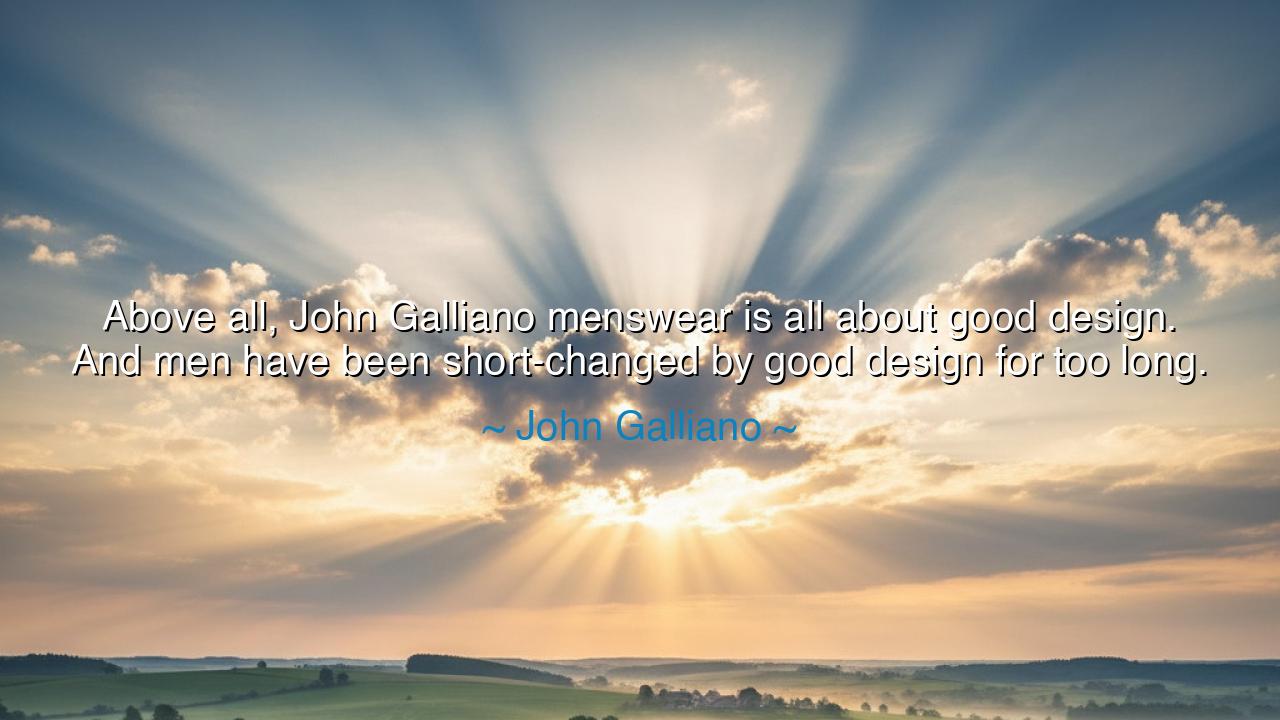
Above all, John Galliano menswear is all about good design. And
Above all, John Galliano menswear is all about good design. And men have been short-changed by good design for too long.






“Above all, John Galliano menswear is all about good design. And men have been short-changed by good design for too long.” Thus spoke John Galliano, the visionary who transformed fashion into theater and fabric into philosophy. His words resound with both passion and lament—a declaration not only of style, but of justice. For Galliano, good design was never a luxury; it was a birthright of beauty and intelligence, something every human deserves to live among and wear. And in this statement, he mourns that for too long, men have been denied this fullness of creative grace—that while women’s fashion evolved into poetry, men’s remained bound by the dull chains of convention.
Galliano’s voice rose from the heart of an era when the boundaries of menswear began to tremble. He came from a tradition of fearless invention, where clothing was not mere covering but expression—an art of identity, emotion, and power. Yet even as he revolutionized the runway with extravagance and soul, he saw the imbalance: that men had been given the uniform but not the imagination. His lament that “men have been short-changed” speaks to something deeper than fabric—it speaks to a spiritual poverty, a world where half of humanity was told not to feel, not to adorn, not to dream through design.
The origin of Galliano’s sentiment can be traced to the long lineage of fashion itself, where women were permitted the luxury of change, and men the burden of tradition. In the courts of Europe, once, both genders dressed like monarchs of myth—embroidered silks, jeweled coats, powdered wigs, plumes of peacock and gold. But as time passed and the industrial age rose, men’s attire grew austere, as if reflecting the mechanical age’s cold precision. The poet Oscar Wilde, another prophet of beauty, once rebelled against this tyranny of dullness, crying that to deny beauty is to deny the human soul. Galliano’s words are a continuation of that rebellion—a reminder that design is not frivolity but freedom.
To illustrate his truth, consider the story of Beau Brummell, the 19th-century English gentleman who transformed men’s fashion with elegance and intellect. At a time when excess ruled, Brummell pared clothing to its essence—perfect tailoring, fine fabric, effortless grace. He understood that design was not about decoration, but about dignity. In his refinement, he elevated simplicity into art and taught that what one wears reflects what one values. Galliano’s own philosophy mirrors Brummell’s but expands it: where Brummell freed men from excess, Galliano sought to free them from banality. His menswear celebrated individuality again—color, form, emotion—a reminder that design must serve not only function but the human spirit.
In Galliano’s words, one also hears the call to balance intellect and emotion in creation. For to him, “good design” meant more than symmetry or craftsmanship; it meant empathy. The designer must understand the human condition, not just the human shape. The curve of a lapel, the weight of a fabric, the movement of a sleeve—each carries meaning, each speaks to how a man sees himself in the world. And when men are offered beauty, comfort, and daring in their clothing, they are also offered permission to feel, to express, to be more fully human.
Galliano’s lament thus becomes a challenge: to restore to men the right to beauty. In every era, the measure of civilization has been the care it takes in shaping the things it makes. The Greeks built temples whose proportions spoke of divine harmony; the Japanese crafted kimonos that turned motion into poetry. When design becomes thoughtless, life itself grows coarse. To deny half the world access to artistry and imagination is to impoverish us all. Therefore, Galliano’s cry for good design in menswear is in truth a cry for equality of expression—an insistence that the aesthetics of life belong to every soul, not merely a chosen few.
The lesson is clear: design is not vanity—it is vision. What we wear is the language of who we are, and to neglect that language is to silence part of our being. Whether one is an artist, a craftsman, or simply a man dressing in the morning, one must learn to honor form and meaning together. Choose things not merely for use, but for truth; seek not extravagance, but excellence. Let beauty not be confined to galleries or women’s wardrobes—it must live in our daily lives, breathed into every shirt, every shoe, every gesture of design.
And so, John Galliano’s words endure as both lament and prophecy. He reminds us that good design is not about excess or fashion—it is about human dignity and imagination. Men, long restrained by convention, must reclaim the right to express their inner worlds through the outer form. For when we surround ourselves with beauty that has purpose, we live more consciously, we move more nobly, and we begin to reflect the harmony of creation itself. Let every stitch, every line, every choice be a celebration of that ancient truth: that design, at its highest, is the soul made visible.






AAdministratorAdministrator
Welcome, honored guests. Please leave a comment, we will respond soon